|
Mexico City
Equipment Overhaul
My shorts began to tear along the way. I sewed them, but they tore again next to my mending. I found a street full of bicycle stores, mostly with material of poor quality, but I could not find any shorts. They only had tight lycra shorts which I do not wear when traveling long distances—I need pockets. At least I bought new CatEye mirrors, left and right, identical to the one which I had broken. The price of 7 USD each was fantastic. In our country, they are sold at about 25 USD. At the hotel, I solved the shorts' problem. As I was walking down the hallway, it seemed to me that I could hear the clatter of a sewing machine. A woman in an office was mending towels. So I negotiated with her and an hour later the critical tear next to the pocket was patched with a piece of material and expertly stitched. I asked about the price and she said that it was nothing. I gave her 20 pesos and the lady was very happy. I was even happier, perhaps I would finish the journey in those shorts.
Oh, my Head!
I had to laugh, but it probably happened to me every time. I arrived in Mexico City, put the bike on the balcony and told myself that I would spend the following week sightseeing without the bike. In the course of the whole seven weeks I had not had any trouble, no aches or pains. But on the first night in Mexico City, I was woken up by intense pain in my left calf. Had I planned to continue the next day on the bike, surely this would not have happened. But my head knew that there was going to be no effort on the following day due to the week-long rest, so it was reminding me that I had been giving my organism a hard time. It had happened to me in Tasmania, for example, with a toothache so intense that I decided to go to the dentist at the earliest opportunity. But then it started to pour with rain, so there was no time for bullshit, the body had other things to do and other priorities, so the mind suppressed the toothache. I think we have no idea how much the psyche affects our health.
I treated the pain in my leg as usual, by applying a Priessnitz wrap and two hours later it was cured. In fact, I had some minor health problems on the way, two actually. First an abscess appeared beneath a tooth. I healed it in a few days by rinsing with hot tea and then by squeezing. I did not know what my dentist would have thought, but it worked. The second problem seemed worse. All of a sudden, large spots appeared on my legs, spreading in the following days and I was worried about what was going to happen. Fortunately, they did not itch, but looked awful. After about 14 days, they gradually disappeared. I do not know what they were, insect bites, allergies to something, passing through a contaminated puddle of water (it was not under my socks), it’s hard to say.
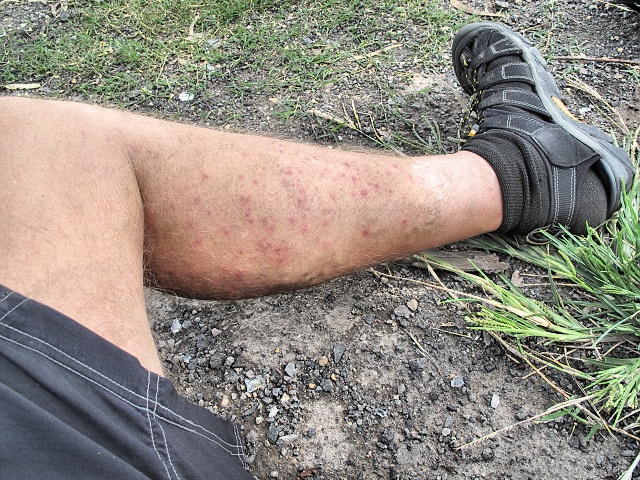
[Near Tequila] Leg rash in its worst stage
Wall Paintings - Murals
Mexico is famous for its 20th-century wall paintings. One of the leading creators of this kind of art is Diego Rivera. His murals and the frescoes of his disciples, which were created under his direct supervision, can be seen in the Secretariat for Public Education, which is located a short walk from the Zócalo. This is a Federal building, so it is guarded by heavily armed cops. I said I was going to look at the frescoes. They asked me what country I was from, identified the República Checa as acceptable and so told me to wait. A moment later, my bodyguard arrived and I went through a security check just like at an airport. The guard led me to the other end of the extensive premises. After a while, I was assigned a tour guide who spoke only Spanish, and who gave me a detailed explanation of the various frescoes for more than an hour. On the planta baja (ground floor) there were work- and folk festival-themed frescoes. The real fun began on the first floor, where the theme was Revolution. The Red Star and tools (hammer and sickle), determined revolutionaries armed with cartridge belts, disgusting capitalists sucking the working people dry and counting their fat profits. In my basic Spanish, I told the lady that I wished Rivera could have lived under Communism, because I had lived under it for 40 years and it was terrible. The tour guide was a bit shocked, but then she offered to give me about a kilogram of Rivera’s reproductions. I would have liked to have accepted, but I could not carry them on the bike. So I explained this to her and we parted amicably.
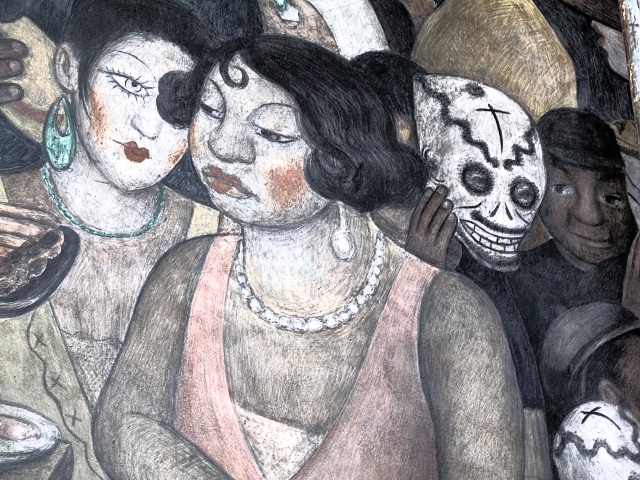
[Mexico City] Secretaria de Educaión Pública - detail of fresco by Diego Rivera with the theme of Day of the Dead
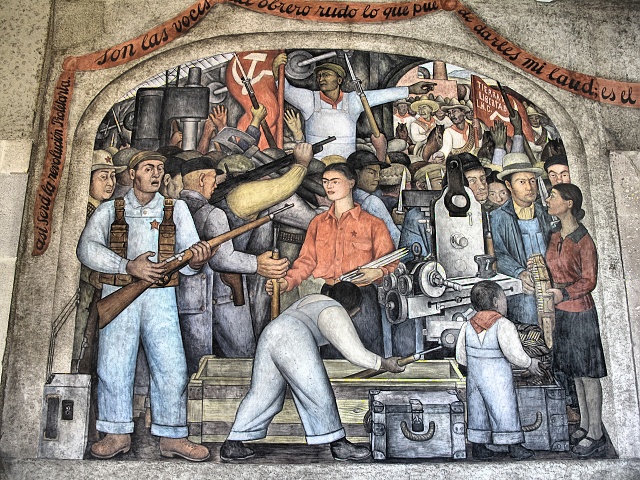
[Mexico City] Secretaria de Educaión Pública - Rivera was a communist and let it be strongly known through his works; I wish he had lived in it for 40 years!
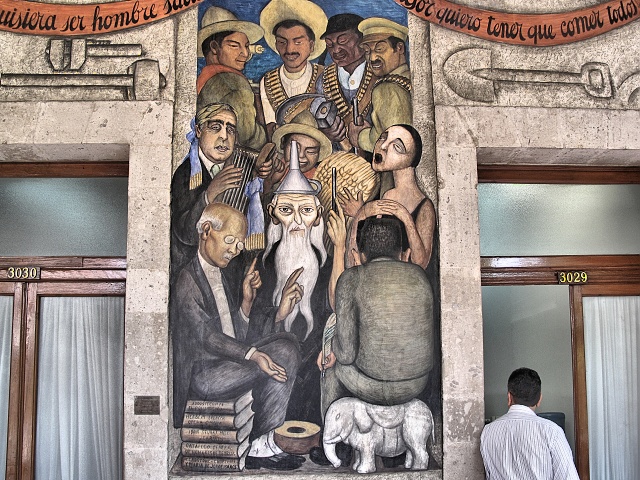
[Mexico City] Secretaria de Educaión Pública - while intellectuals debate, Emiliano Zapata is already fighting and officials in the real world are smoking in the hallway
Foolproof Subway
There is nothing easier than traveling on the Mexican underground. For 3 pesos (25 cents) you buy a ticket, stick it into a turnstile and you are in the system. Then you can travel freely on a total of 11 subway lines, change trains without limitation (which has the side effect that in off-peak hours many dealers roam around the underground, offering all sorts of things, the typical price being 5 pesos). I do not know how the Prague transport company does business, as a Metro ticket is so much more expensive, costing 1.5 USD. While local distances are very short, the carriages are comparable to those in Prague. The Metro runs on rubber wheels, not on rails. In its peripheral section, the routes are above ground. The information system is very simple: exits are marked at each station with the links to other routes (transfers), including the terminals of the routes. Each subway station has its own graphic logo, so you do not even have to be literate. The only problem is the long distances that must be walked on some transfers, even hundreds of meters. For this reason, when planning a route, the best tactic is to minimize the number of transfers. The Metro is definitely not barrier-free, there are many steps, mostly there are parallel escalators, but not always. Worth mentioning is that some carriages are reserved for women and children in peak hours, these are marked by bold lines on the platform and generally respected.

[Mexico City] Foolproof information system in Metro – 'corespondencia' means 'transfer' to another line, and one just needs to remember the destination station of any given line
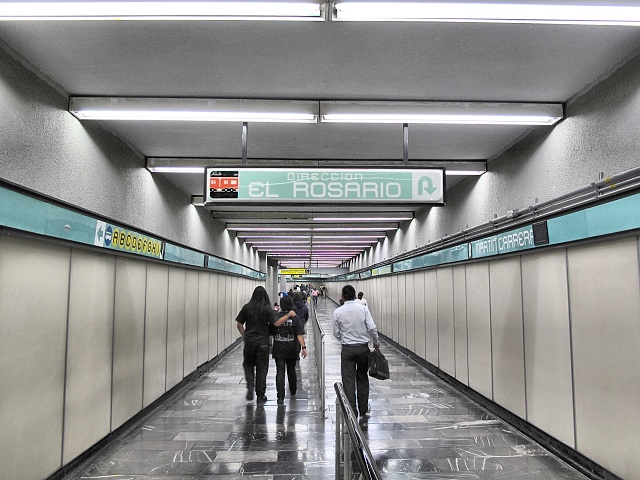
[Mexico City] The only drawback of the Metro are the long transfers, it happened that I often had to walk even three-quarters of a kilometer
Basílica de Guadalupe
The Basílica de Nuestra Senora de Guadalupe is a first-class religious attraction. It was built on the Tepeyac Hill, where in 1531 the Virgin Mary appeared to Juan Diego and sent him to the Bishop with a message to build a church on the hill in her honor. The Bishop ignored him. The revelation was repeated, and, at the fourth one, the image of the Virgin Mary was burned on to Diego's cloak. This finally convinced the Bishop and the church was built, coincidentally on the spot of an original Aztec shrine. A cult rapidly formed around this event, the image became famous and its reproduction can be seen virtually everywhere in Mexico. Our Lady of Guadalupe became the patron saint of Mexico and then of the whole of Latin America. There are several churches on the site. In 1970, a very modern new basilica was built, which seats up to 40,000 people. The access to the image was solved ingeniously. It hangs above the altar, but in the floor of the altar there is a large hole through which it is possible to see the image from a lower level. To prevent the accumulation of crowds viewing the image, it is possible to see the image only on a mobile belt, there are four of them, two running in one direction and two in reverse. So the viewing of the image does not disturb the Mass, which is magnificent and celebrated almost continuously there. Further extensive construction works are now taking place in the neighborhood of the new cathedral. The demand to see this famous image apparently is continuing to increase.
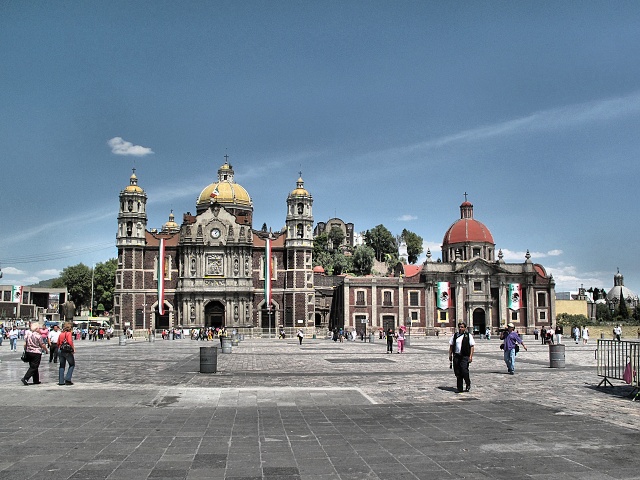
[Mexico City] Basílica de Guadalupe – the original basilica
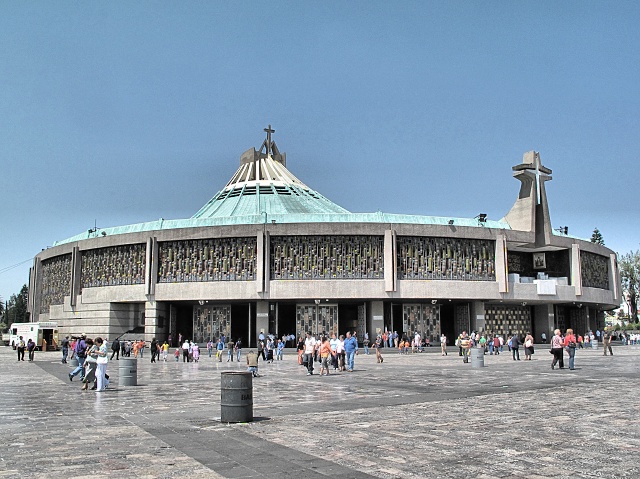
[Mexico City] Basílica de Guadalupe – the demand was so huge that this basilica, which can hold up to 40,000 people, was built in 1970
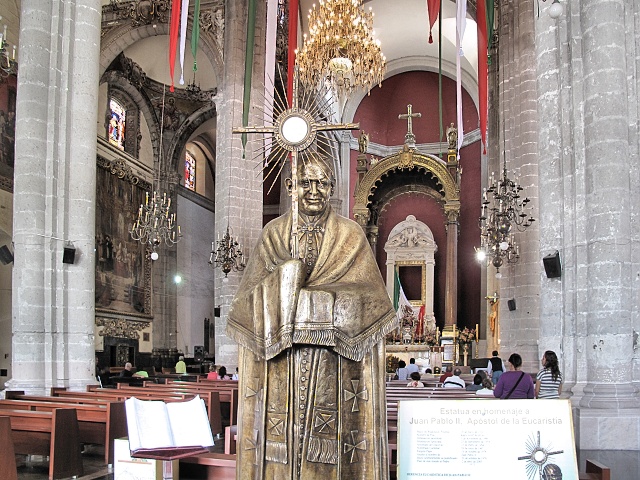
[Mexico City] Basílica de Guadalupe - the statue of John Paul II, in the background an empty altar, the painting of the Virgin Mary was moved to the new basilica
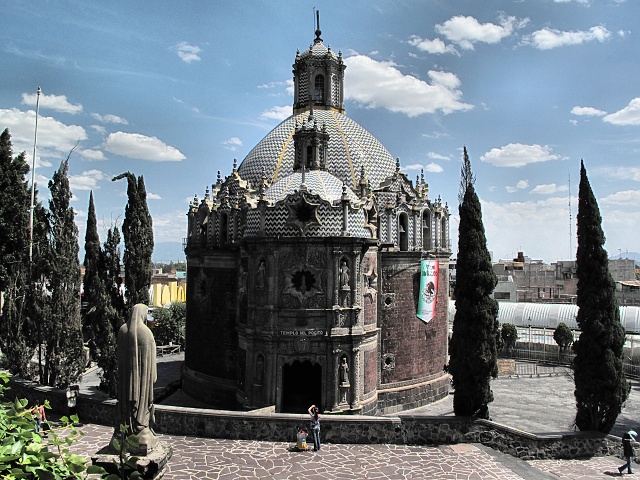
[Mexico City] Templo del Pocito in the area of Basílica de Guadalupe
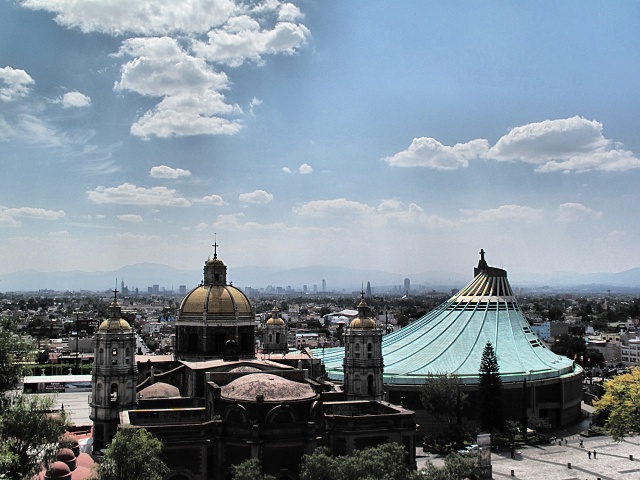
[Mexico City] Basílica de Guadalupe – in unison, the old and new buildings overlook the town center about 6 km away
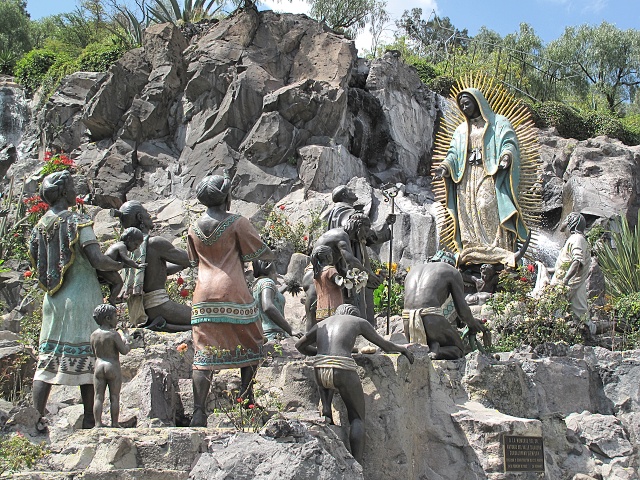
[Mexico City] Basílica de Guadalupe - Indians bringing gifts to the Virgin Mary de Guadalope
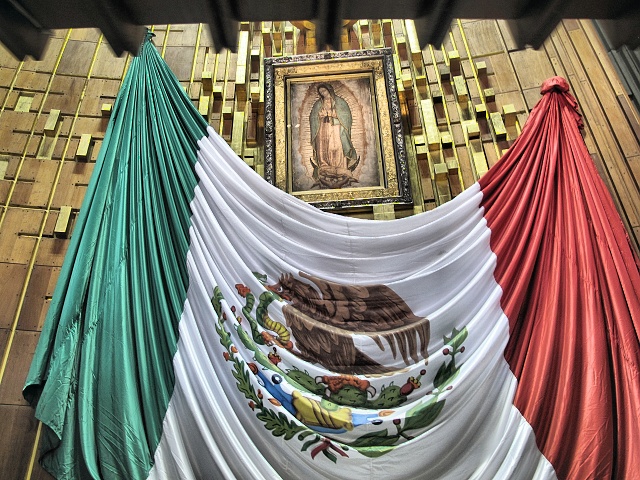
[Mexico City] Basílica de Guadalupe - the image venerated throughout Latin America is installed on the altar of the new basilica
A Fool in Teotihuacán
Teotihuacán is located 50 kilometers North of Mexico City. Buses from Mexico run every 30 minutes, the trip takes an hour and costs 35 pesos. I set out early in the morning, as I feared the crowds of tourists described in the guidebook. When I arrived just before 10 a.m., there were more souvenir vendors than visitors. At around noon, the number of tourists had slightly increased, but were lost in such a vast area. And now about the Fool. I climbed the first pyramid, La Ciudadela, started taking photos, lifted my hat a little, so as not to disturb the photos, and then the wind took it and blew it on to an inaccessible spot on the pyramid. There was a 2.5-meter wide smooth rim of the stairway, very steep, between the steps and my hat. At first I wanted to ask the workers in the nearby archaeological site to lend me a long rope or rod. But then I organized a rescue team of passing tourists who held my hands and secured me to the steps. I climbed over the rim and the hat was on my head again. Only I did not feel very good about it, such inattention cannot be tolerated.
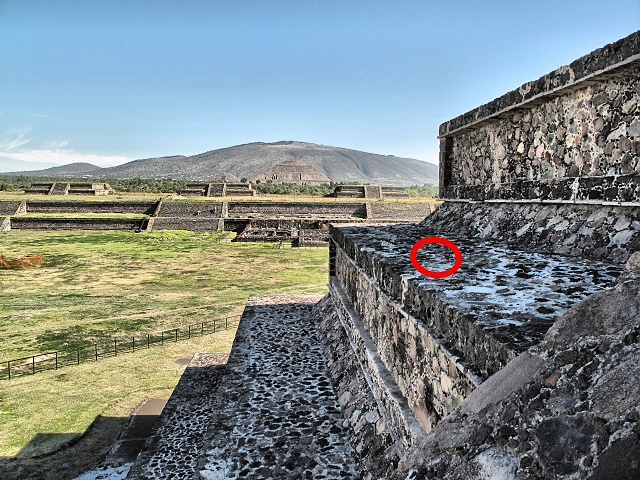
[Teotihuacán] Ciudadela - my hat flew off, on to this inaccessible spot
The best of the citadel could not be seen, due to repair of the access to the wall on which there were sculptures of the rain god, Tláloc. It could only be seen from a distance and from a specific angle. Then I walked along the large Path of the Dead to the Sun Pyramid, which is the third largest pyramid in the world. It is possible to climb to the summit, which is the obvious duty of every visitor. The view from it is great, but an even better view is offered by the Moon Pyramid, which lies at the end of the Path of the Dead. Only the first step is accessible. Climbing the steep steps makes one tired, so I gratefully visited all three museums exhibiting the artifacts and frescoes that were brought down from the interior walls of several local palaces. It was a day trip, but worth it.
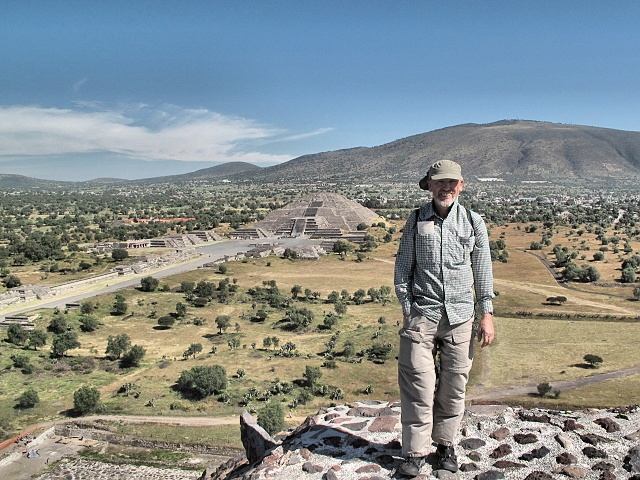
[Teotihuacán] Pirámide del Sol – I am on the top of the Pyramid of the Sun, with the Moon Pyramid in the background
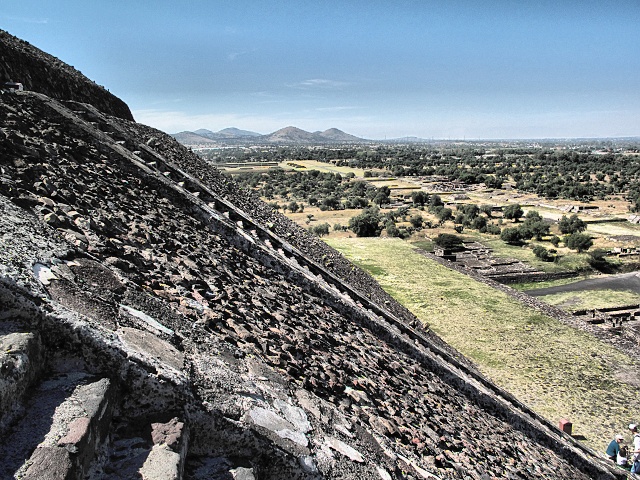
[Teotihuacán] Pirámide del Sol – the climb is quite steep, even I could not have cycled to the top
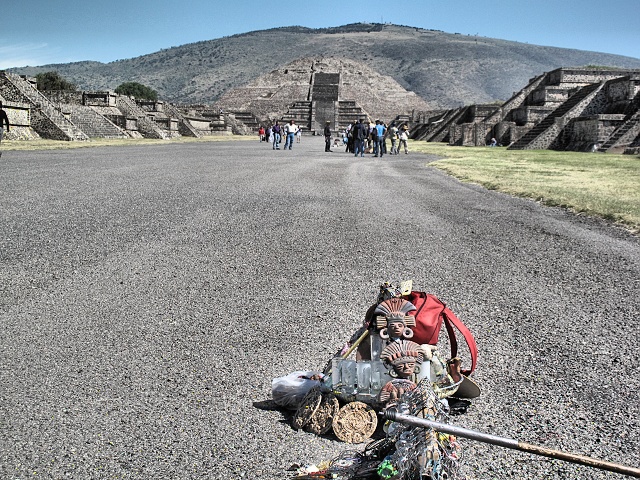
[Teotihuacán] Calle de los Muertos – omnipresent sale of trinkets on the Path of the Dead
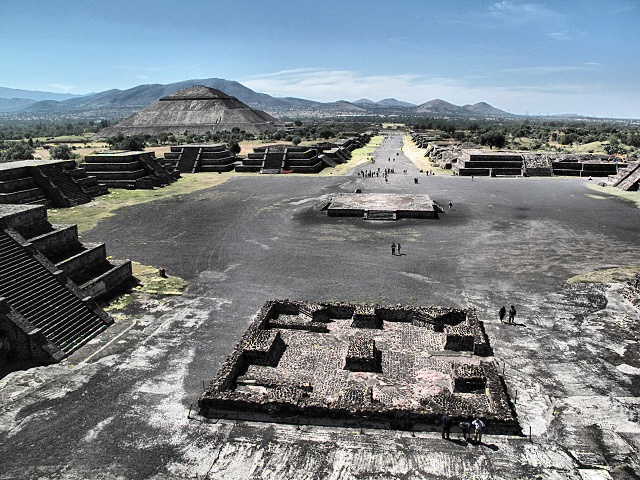
[Teotihuacán] View from the Moon Pyramid to the Path of the Dead and the Pyramid of the Sun on the left
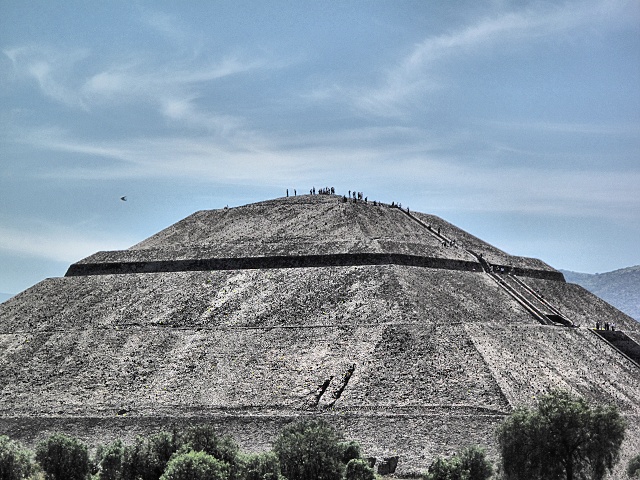
[Teotihuacán] Pyramid of the Sun
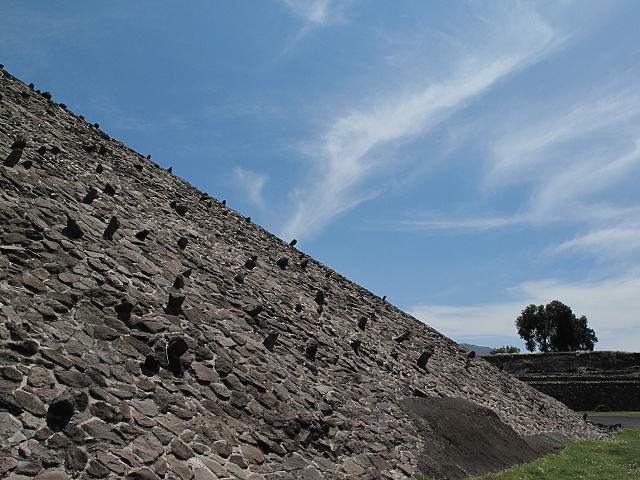
[Teotihuacán] Pyramid of the Sun
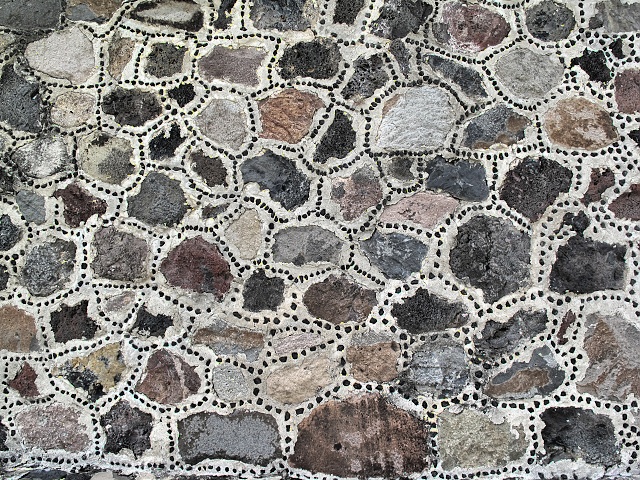
[Teotihuacán] Detail of a temple wall
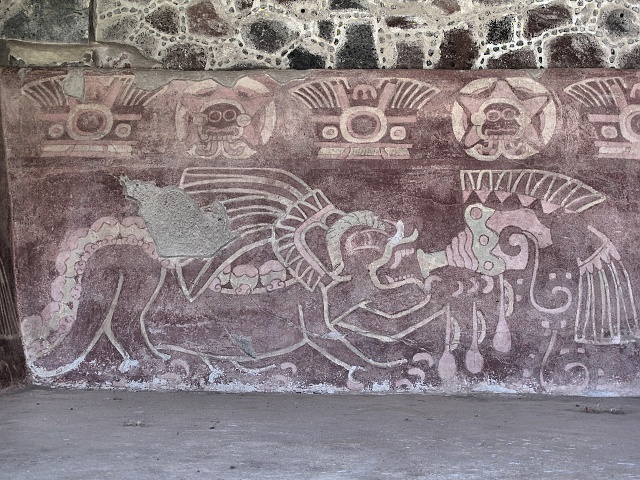
[Teotihuacán] One of the best preserved frescoes – a jaguar drinking water
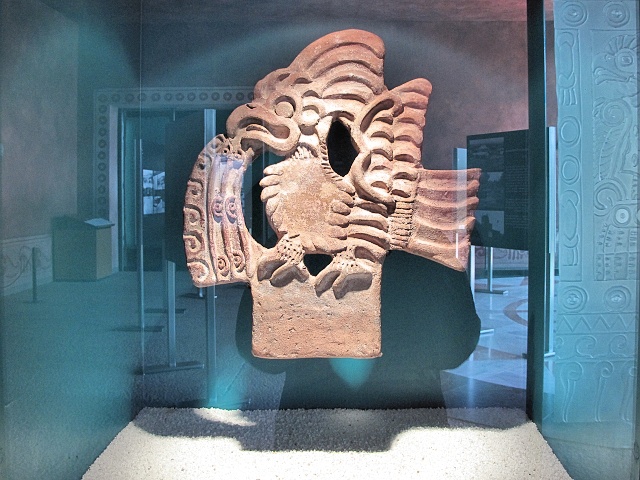
[Teotihuacán] Relief in the local museum of a bird spitting out water

[Teotihuacán] Lonely little man - one of the findings in the local museum
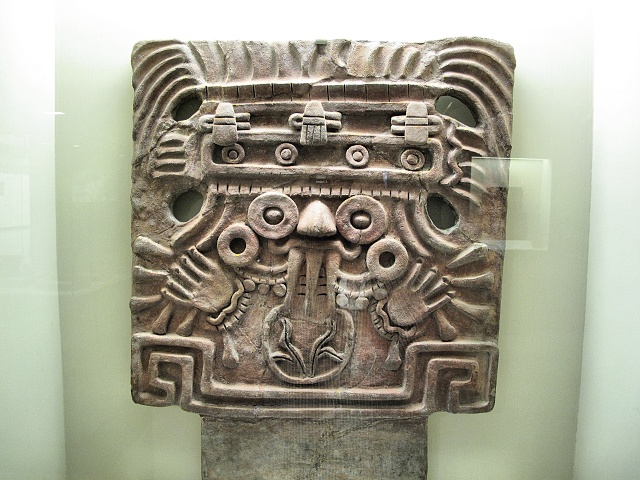
[Teotihuacán] Head in the Museum of Frescoes
Xochimilco
On the South side of the city, but still within easy reach of public transport – the Metro and connecting suburban train (also a fare of 3 pesos, as for the Metro) – is a vast network of canals. The Aztecs already used them and grew food on the legendary floating gardens. Today it is mainly a tourist attraction, but several floating gardens are still operating. The owners sail on the canals on barges driven by long poles, like Venetian gondoliers. From the train station, I was already guided by a barker to a dock about 1 kilometer away. I arrived there with one Dutch tourist. The ship owner wanted 200 pesos for three-quarters of an hour from each of us. So I pulled out the Lonely Planet and showed him that the price ranges from 140 to 160 pesos per hour. We agreed on 150 pesos per hour each and set off. Although it was a weekday morning, some canals were surprisingly full. There were ships, groups of tourists on board, drinking and eating, accompanied by musicians. These ships were gradually joined by traders in smaller boats, like ours, offering their goods and when they had exploited a ship, they left and went elsewhere. Our gondolier took us to a quiet spot where there were no people and where it was possible to thoroughly enjoy the voyage.
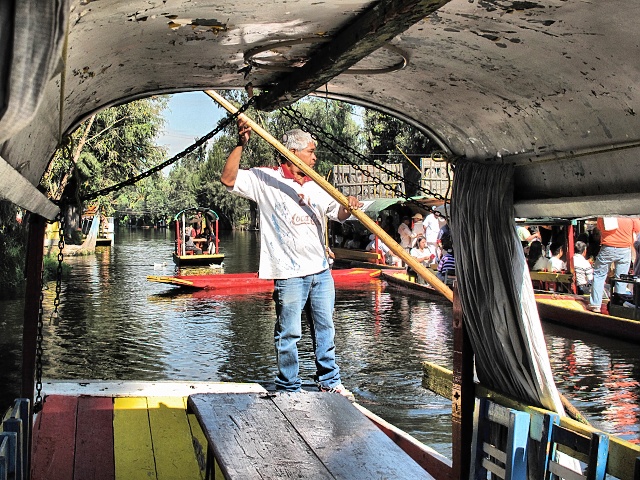
[Xochimilco] Our gondolier transports us on the former Aztec canals
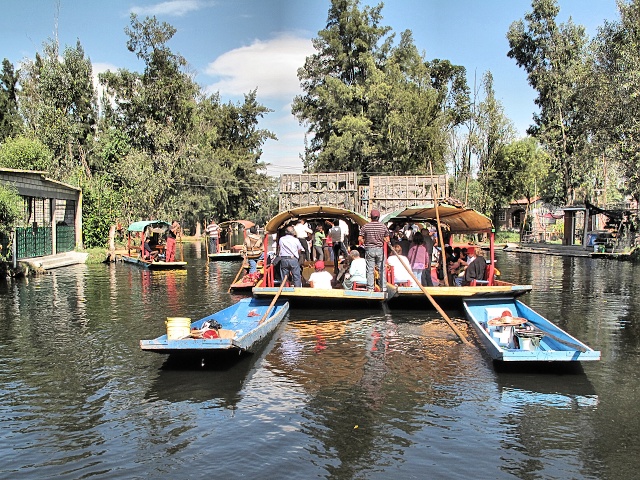
[Xochimilco] Merchants anchor their two boats, offering various goods for sale
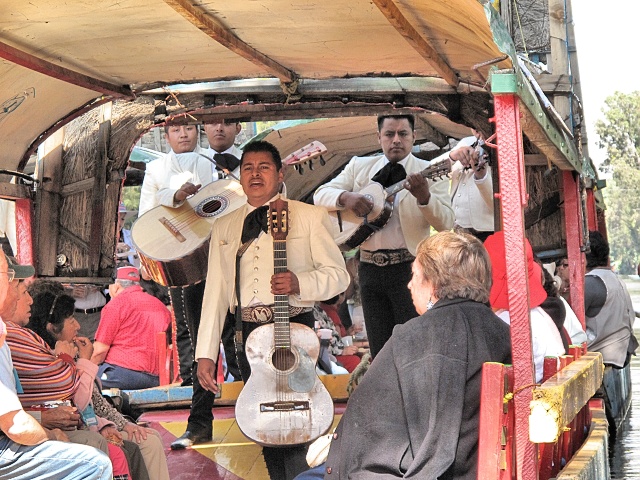
[Xochimilco] Mariachis play popular hits in Mexican style for tourists – they have just sung 'My Way', made famous by Frank Sinatra
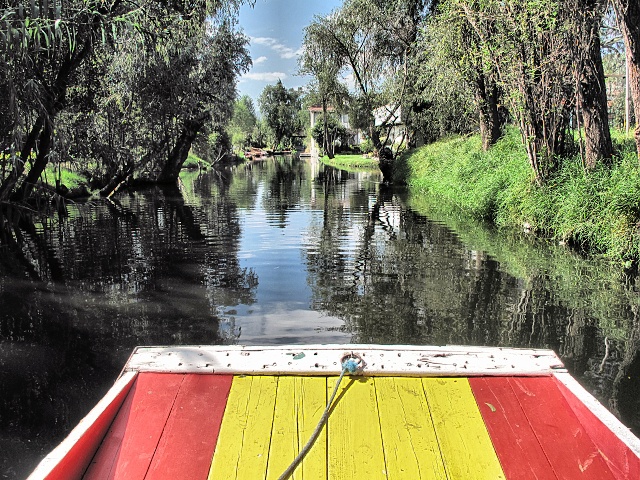
[Xochimilco] Quiet spots could also be found
After this pleasant experience, I also went to the center of Xochimilco. In the marketplace I finally decided to buy a piece of chicharrón, which is baked pork rinds. It tastes like offal, is very good and reasonably unhealthy.
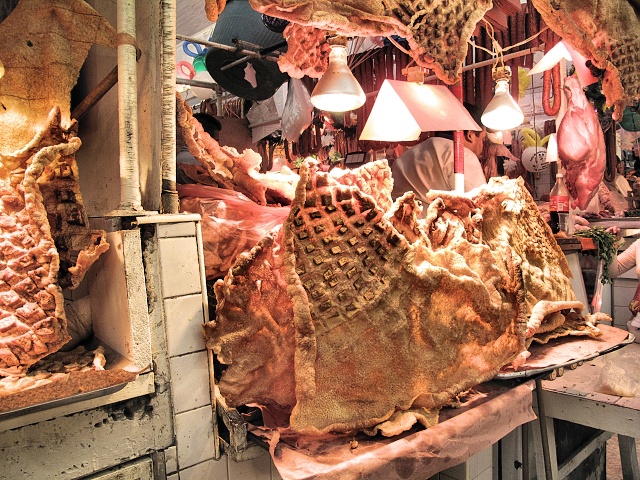
[Xochimilco] Roast pork rinds, very tasty, very unhealthy
I returned to Zócalo. The queue at the National Palace (seat of the President) was short, so I went through two inspections (one by the policemen outside, the other by soldiers inside who are in charge of guarding the Palace). The tour lasted two hours. It was interesting, of course, especially regarding Independence and Revolution, a picture gallery of all the presidents, a tour of the ceremonial areas which are commonly used, and audiovisual performances on four walls and ceiling on the 200th anniversary of Independence. The Palace also has a series of Rivera's murals relating to the history of Mexico from the Aztecs, through the Spanish occupation of the country, up to the struggle for independence. What shocked me was the display of the skulls of Hidalgo, Juaréz and two other freedom fighters in a glass cabinet. However, the Mexican visitors had an enormous interest in them. I asked the guard, but was not allowed to take photos for pious reasons.
Well, I was finally fortunate to enter a cathedral at a time when no Mass was being celebrated, so I could see and photograph the altar, look at the extremely impressive sacristy with huge paintings, climb up the cathedral tower, walk on the domes of the basilica roof and watch the airplanes landing at nearby Benito Juaréz International Airport.
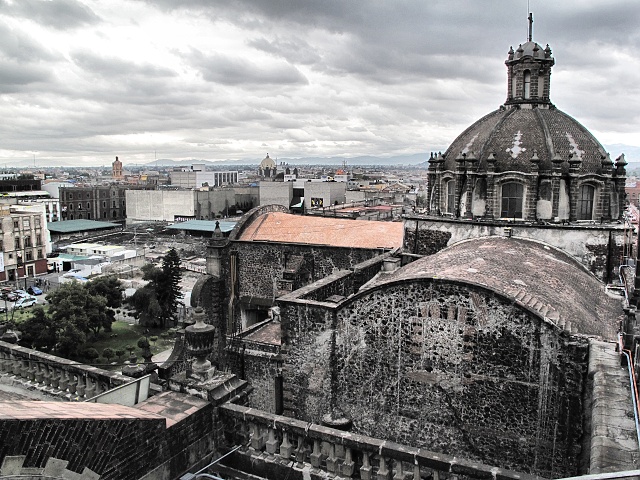
[Mexico City] I also climbed the Cathedral tower and looked down at the town from a height
National Museum of Anthropology
There are many museums in Mexico, but this one you definitely should not miss. On the ground floor are thematically arranged exhibits of individual cultures—Teotihuacan, Toltec, Aztec, Mayan. There are a number of rare exhibits, probably the best known being the circular Aztec altar from the Templo Mayor (mistakenly referred to as a calendar), about three meters in diameter. In the center, the bloodthirsty god, Tláloc, is holding a human heart in each hand. In the basement are accurate reconstructions of the tombs with the original objects found in them. Gigantic Toltec heads weighing about 20 tons. Original frescoes and reliefs from Teotihuacán. Here I realized for the first time how imposing and beautiful the pyramids and surrounding palaces had been. Today they are only bare stone buildings. I still wondered how it was possible that such an advanced civilization could have literally been decimated by a handful of Spanish conquerors.
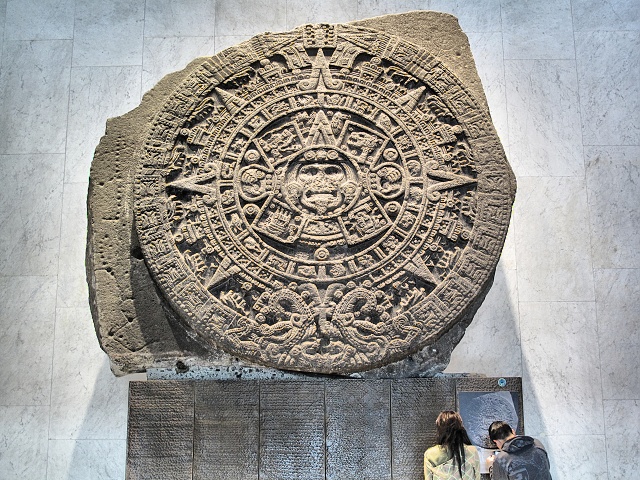
[Mexico City] Museo Nacional de Antropologia - the Aztec altar from the Templo Mayor was initially considered a calendar
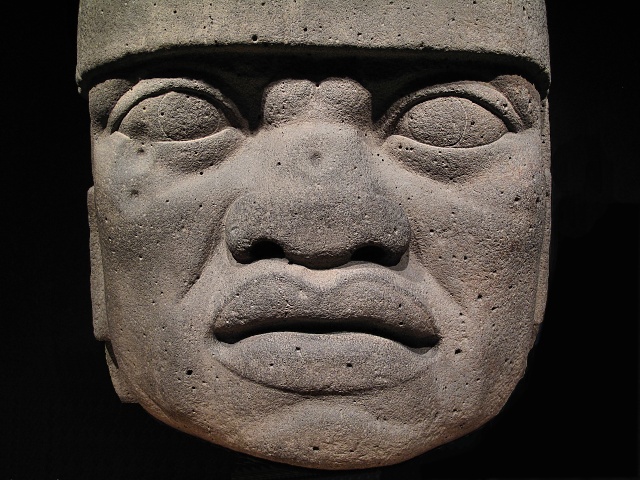
[Mexico City] Museo Nacional de Antropologia - huge Toltec head weighing approximately 20 tons
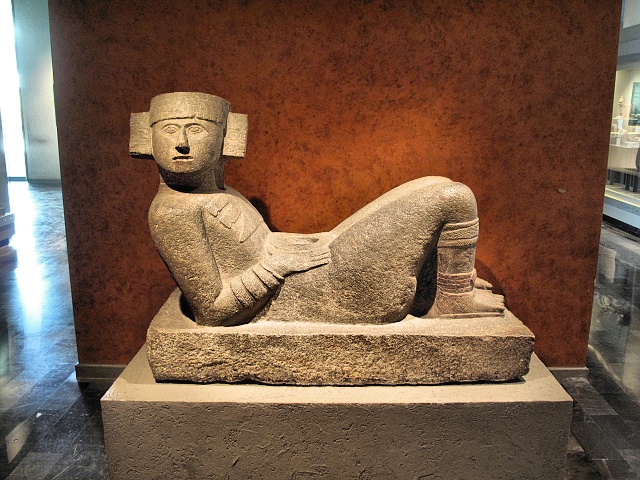
[Mexico City] Museo Nacional de Antropologia - a typical pose for statues of people
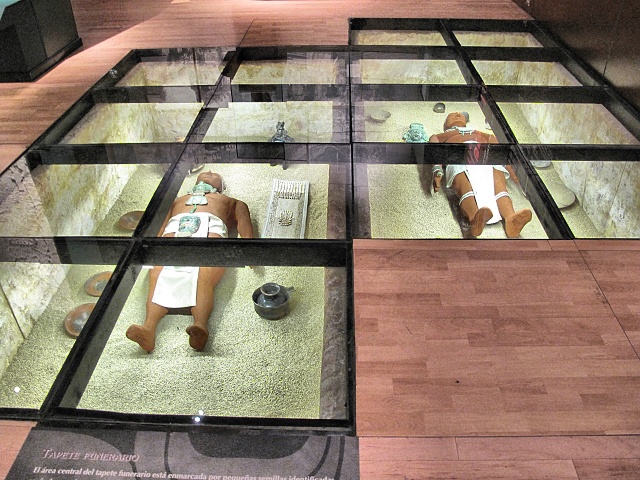
[Mexico City] Museo Nacional de Antropologia - imitation graves in glazed floor
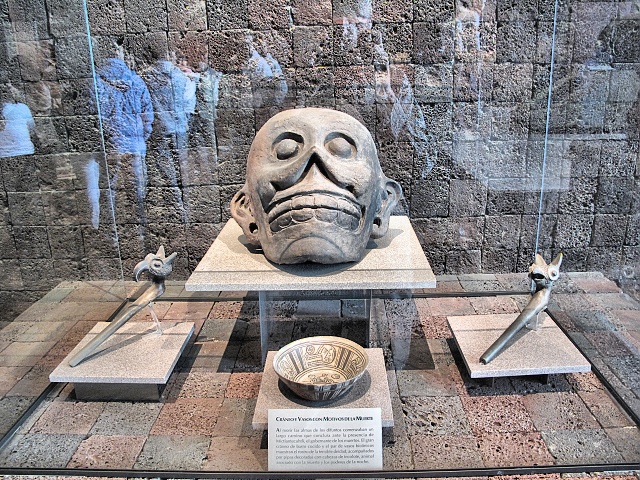
[Mexico City] Museo Nacional de Antropologia - smiling grim reaper
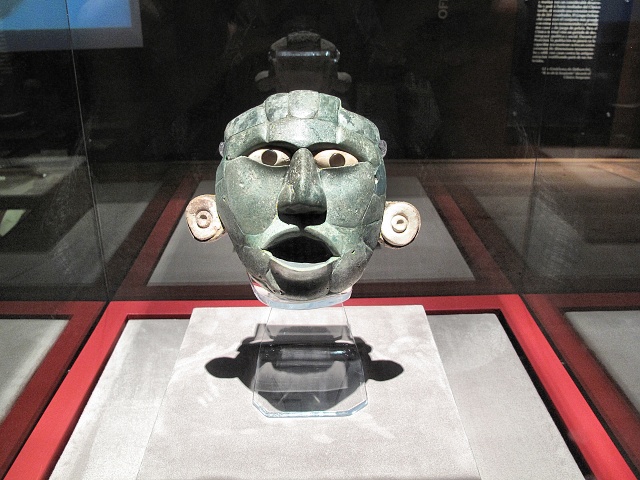
[Mexico City] Museo Nacional de Antropologia - some funeral masks had surprisingly vivid expressions
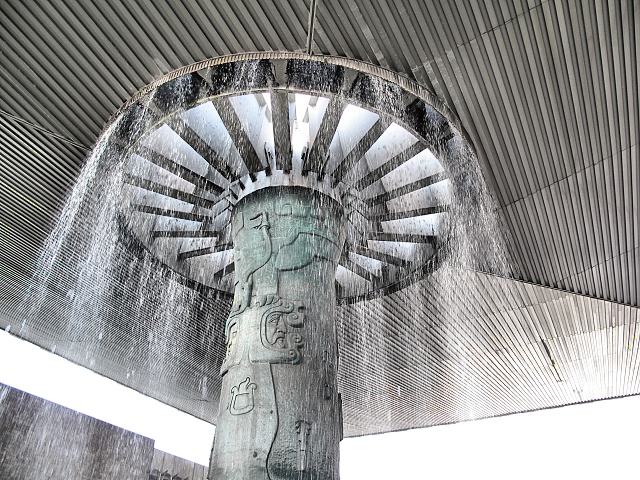
[Mexico City] Museo Nacional de Antropologia - roofed courtyard with fountain in the middle of the roof
Tenochtitlán - Templo Mayor
Tenochtitlán – the Aztec center of the universe — is situated on Zócalo Square right in the center of present-day Mexico City. On the site of the present city, a large Aztec city was located, interwoven by canals and surrounded by a lake. Residues of the canals are still evident in several city streets that are a few meters below the ground level of the surrounding area. In the center, there was a pyramid of about 45 meters in height. Over the centuries, it steadily grew, containing within it premises for the nobility and priests. You can also see the black obsidian stone on which the priests cut out the hearts of prisoners and sacrificed them to the gods, hurling the prisoners' bodies down from the pyramid. The adjoining museum again displays many interesting artifacts, sculptures, vases, death masks, reliefs and interesting reconstructions of ceremonial suits in jaguar skin and feathers.
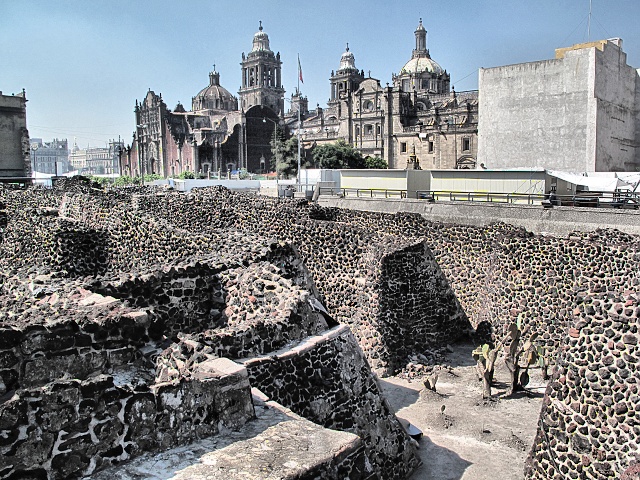
[Mexico City] Templo Mayor – Spaniards destroyed Tenochtitlán and built, among others, also a Cathedral on the site

[Mexico City] Templo Mayor - Tenochtitlán was the Aztec center of the Universe
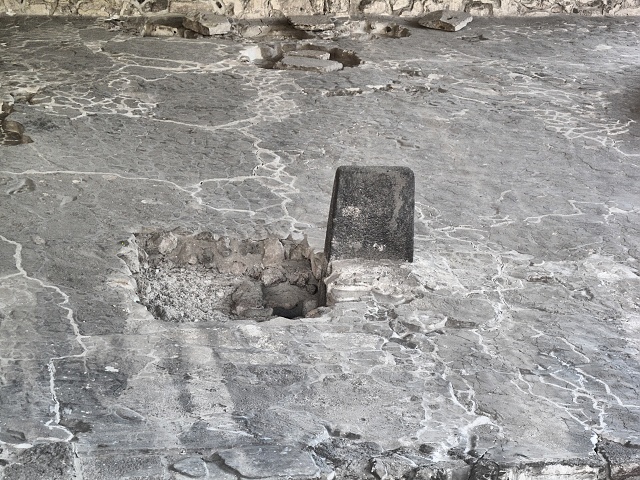
[Mexico City] Templo Mayor - human hearts were sacrificed on the black stone
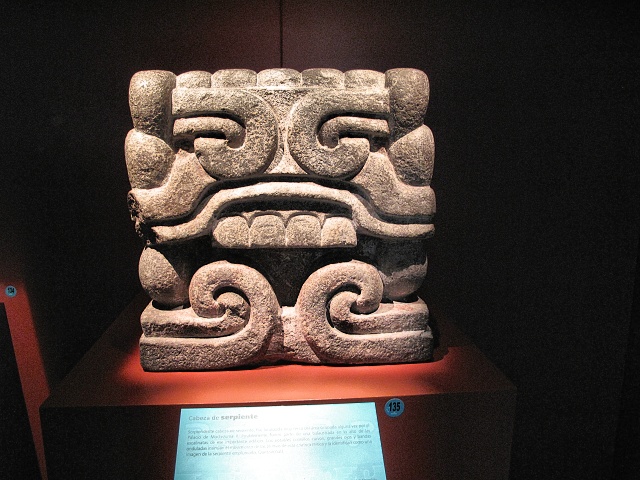
[Mexico City] Templo Mayor - Tlálok - god of water and rain - the most powerful Aztec deity
This Really Made Me Laugh
The Palace of Fine Arts displays a series of wall paintings. One of them is Rivera's painting entitled "Man at the Crossroads", ordered from him by the Rockefeller Center in the 1930s. The unsuspecting Center sponsored by the rich banking family received images of Lenin, Trotsky and the masses of working class militants determined to overthrow capitalism. Although they paid for the painting, the Rockefeller Center had it destroyed. To preserve the beauty for us, Rivera painted it again. Very nice - judge for yourself!
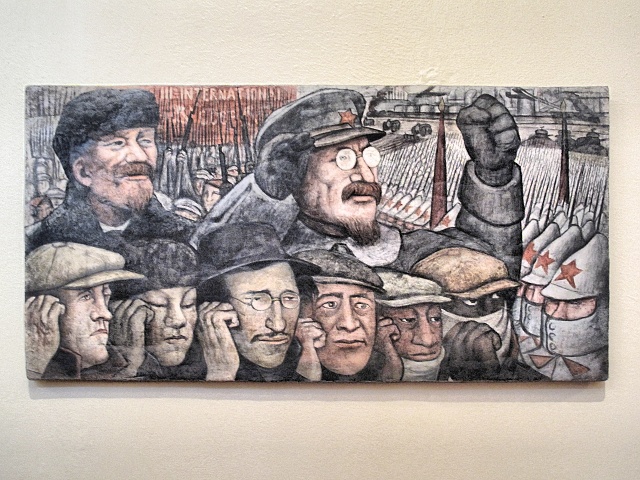
[Mexico City] Palacio de Bellas Artes – Rivera’s painting for the Rockefeller Center – dominated by Lenin and Trotsky
Olé olé corrida de toros
I really wanted to see a bullfight. I asked the hotel and they told me that the season only started in November. On the Internet, however, I found that the Taurino de Lujo Festival was to take place on Sunday 17th October, and so I decided that I would tough it out in Mexico City until the end of the week. In any case, not even two weeks would be enough for all the sights and museums, so I definitely was not going to be bored while waiting. On the Sunday, after 2 p.m. I went to Monumental Plaza México, possibly the largest bullring in the world, which holds 48,000 spectators. There were a lot fewer of us, after all, the good bulls would only be showing up in the high season. Bullfighting is a downright macho affair, everyone smokes cigars (I did not), drinks wine (yes, yes) and beer (yes, yes, yes) and with loud shouts, expresses their pleasure or by whistling and booing their displeasure. Tickets are either in the shade (Sombre) or the sun (Sol). The latter are cheaper. It was cloudy, the sun was not shining very brightly so, like the majority I bought the Sol, in the Primer Tendido for 150 pesos (the most expensive are Barreras for rows 1-7). I was in the eighth row. However, next time I would buy the Sombre, because the shady side is preferred and most fights take place right in front of it.
It is forbidden to take cameras into bullfights and take photos. But we were in Mexico, so if you sneaked a camera in, nobody would tell you not to use it.
It very much depends on the bull. He usually runs into the arena like a king, is there alone, runs around a couple of times and then suddenly comes the shock. Toreadors with muletas enter, some bulls get so angry that they attack the walls of the arena with their horns. But there was also one stupid bull who feared the toreadors and stepped back. Then it is necessary to make the bull angry. Two picadors on horseback with lances stick them into his back. The audience squeals with resentment, it is unsportsmanlike. Picadors on “armored” horses do not bear any risk. Then the banderillos run in, who with greater or lesser success stick spears of about one meter in length into his back. That is a really dangerous job, going head-on against a bull, they get out at the last minute and stab the spear in while they jump out of the way. That makes the bull properly mad and he wants to attack anyone. Fanfares blow and the matador enters the scene. He has 16 minutes to kill the bull. The fascinating performance is reaching its climax. The matador first imposes his will on the bull. Using muletas he turns the bull around him, and fools him so much that he can turn his back to the bull or kneel down in front of him. The audience applauds the tight and elegant turns with loud Olés. There are moments when one shudders. Not that one would have any fear for the matador, but the manifestation of the absolute superiority of a slim man over an angry muscular mass is fascinating. Finally, the matador pulls out a sword, or rather a rapier hidden beneath the muleta, comes face to face with the bull and sticks the blade into the bull's neck. A kill is only allowed from the front. After a good strike, the bull runs around for about one more minute and then suddenly drops down dead. A good kill is appreciated, the matador gets the bull’s ears which are cut off and holds them up to bask in a standing ovation, which is really frenetic. There were 6 bulls, twice the ears were cut off and some kills were performed up to three times. I should add that a matador always came up to the bull for the stuck sword, pulled it out and then stuck it in again. I really enjoyed it! I recommend it!
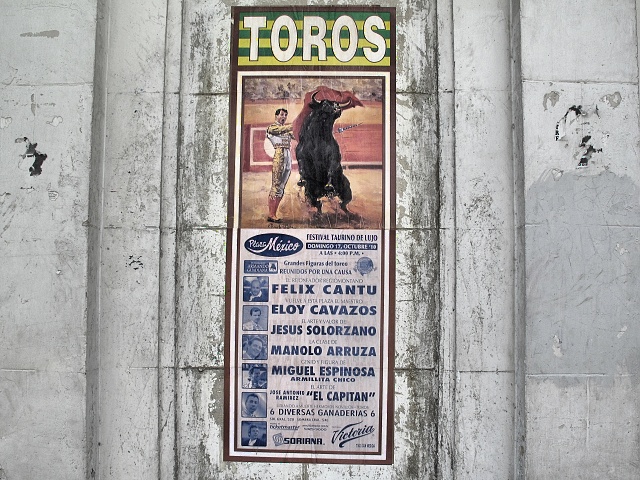
[Mexico City] Bullfight poster
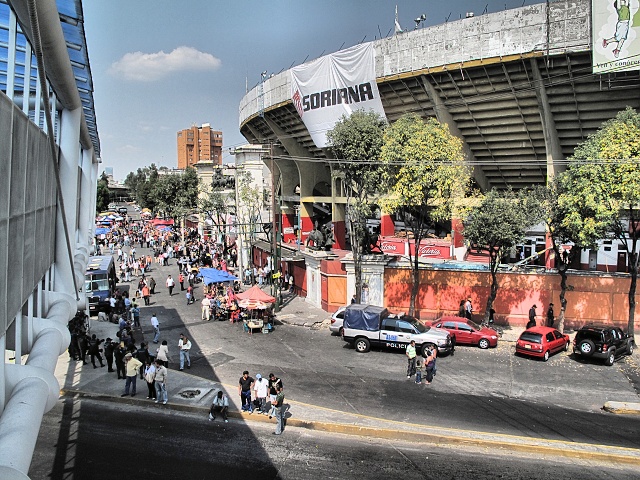
[Mexico City] Monumental Plaza Mexico stadium for 48,000 spectators
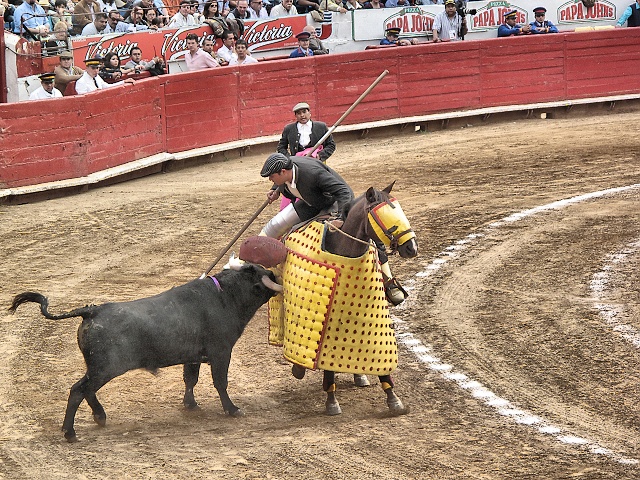
[Mexico City] Picadors prick the bull’s back with lances to make him angry
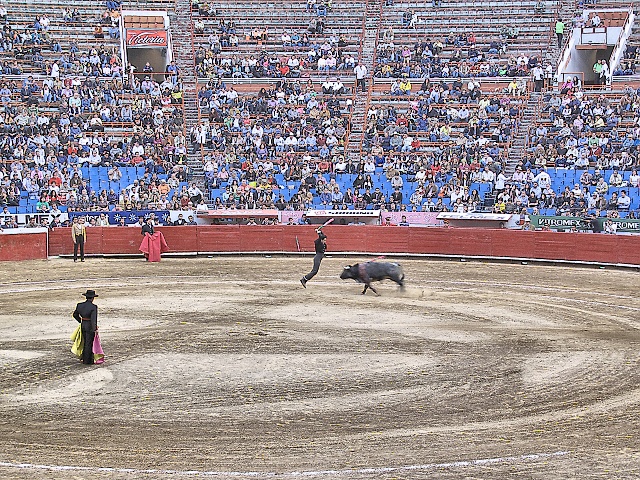
[Mexico City] A bandarillo in a beautiful leap, with the spears in the bull’s back
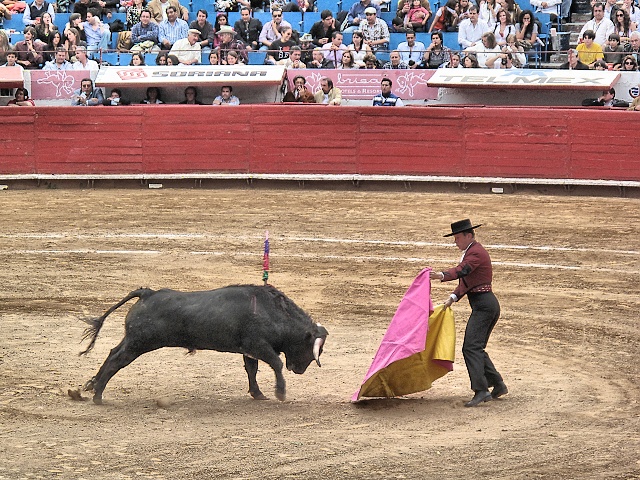
[Mexico City] A toreador toying with the bull
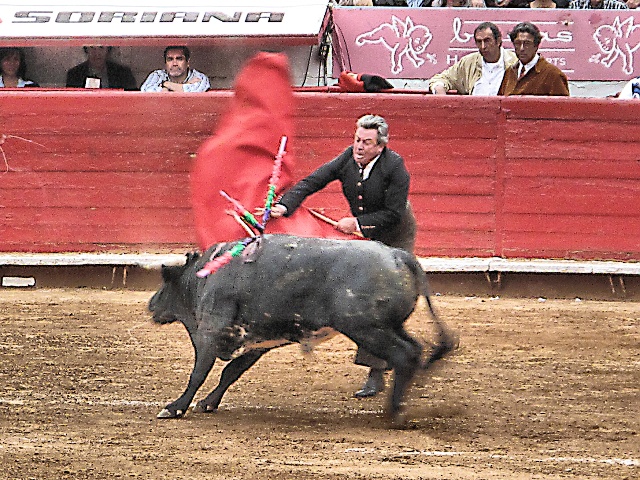
[Mexico City] A matador’s work is hard, he must be elegant and get very close to the bull, this is appreciated
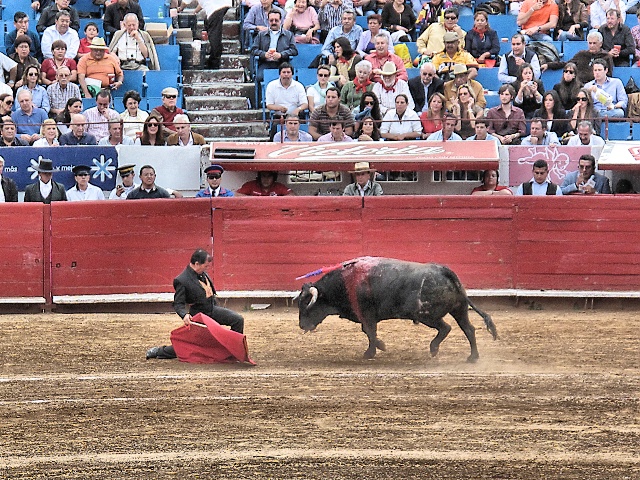
[Mexico City] The matador has gained control over the bull already and so he can even kneel down
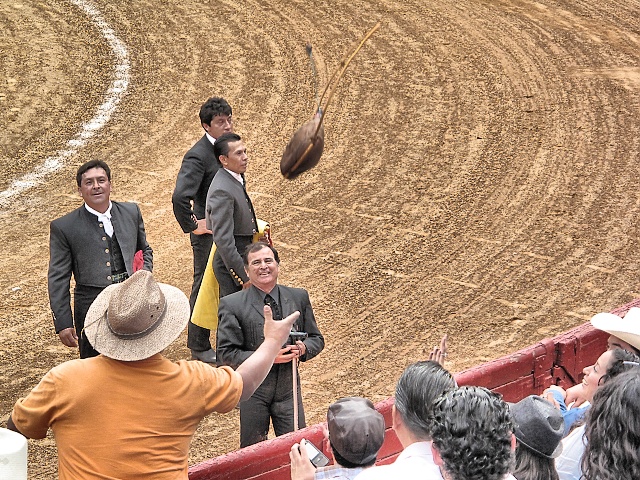
[Mexico City] A spectator throws a bottle of wine to the successful matador who drinks it and returns the bottle
From the Biggest City in the World
I add a few snapshots.
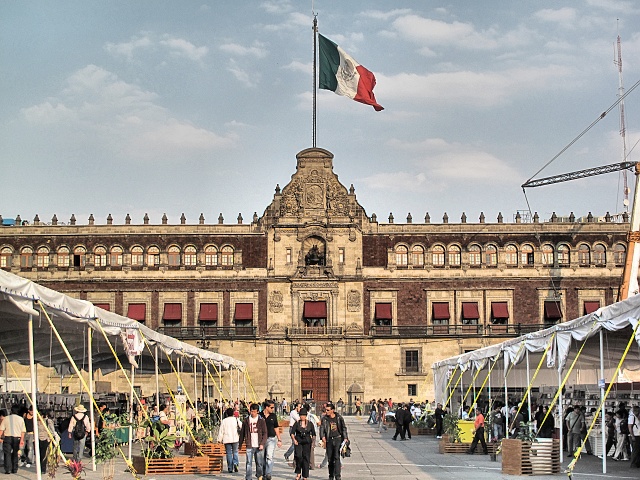
[Mexico City] Zócalo - Palacio Nacional
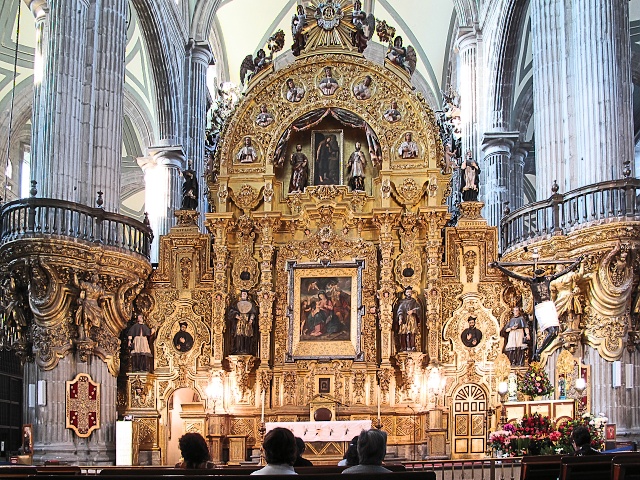
[Mexico City] Catedral y Sagrario Metropolitano – one of the altars
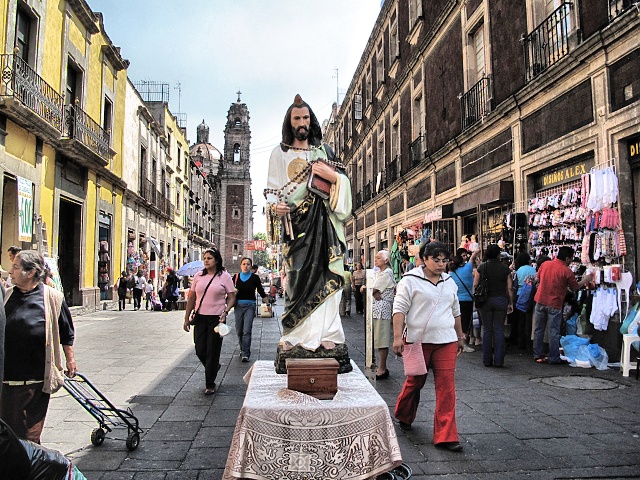
[Mexico City] Someone erected the statue of Christ in the middle of the street with the obligatory money box
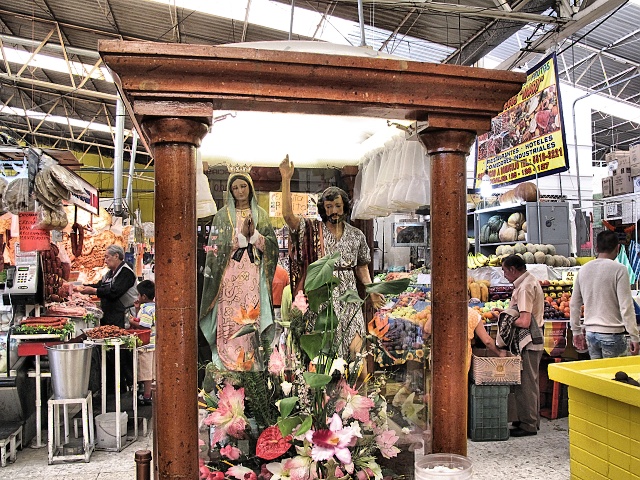
[Mexico City] Mercado San Juan - a small chapel in the middle of a marketplace
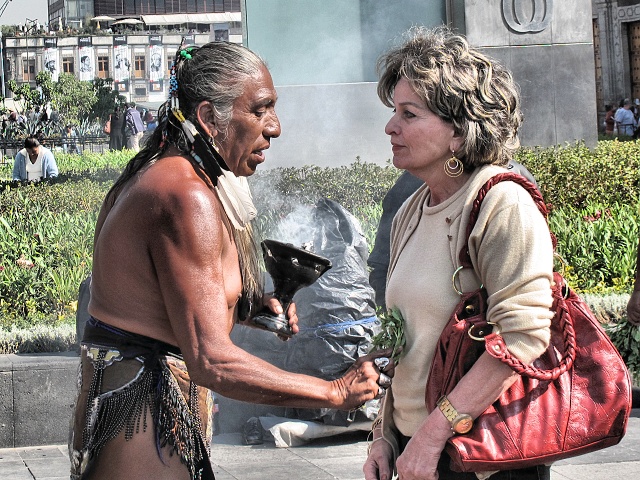
[Mexico City] Zócalo – a shaman purifies a lady from evil spirits - I preferred to keep my spirits
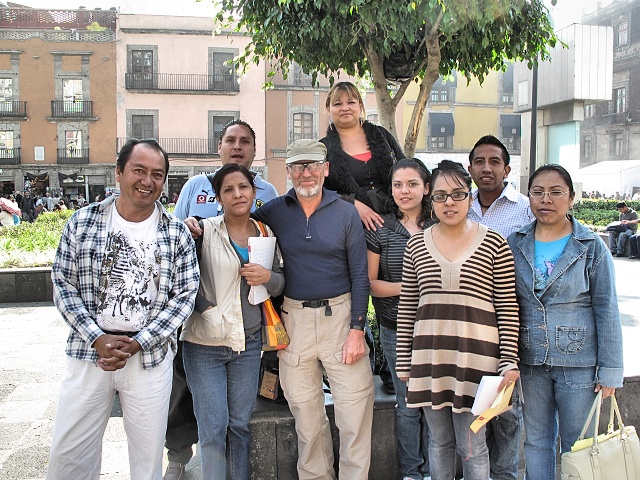
[Mexico City] Zócalo – English students tried their communication skills on me and then we had our photo taken
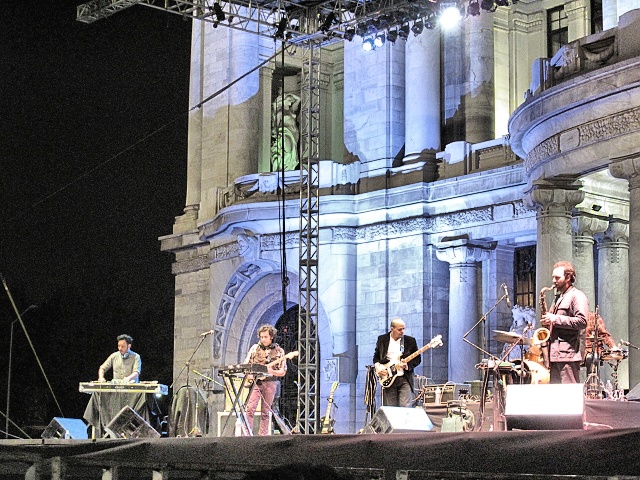
[Mexico City] Palacio de Bellas Artes - free jazz concerts were held on stage in front of the Palace every evening
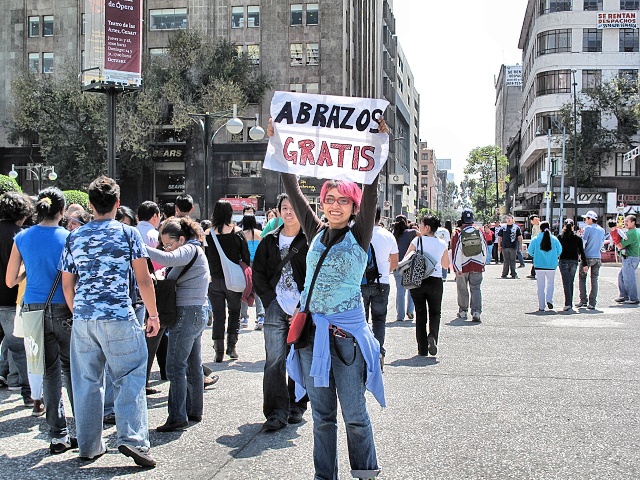
[Mexico City] Park Alameda - girl offering a free hug; free hugs also reached Mexico - I did not skip them
| 

































































